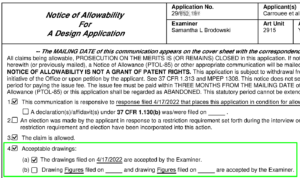
Hello design patent colleagues. This blog article presents the first of three practice tips for prosecution of US design patent applications.
When a design patent application gets allowed, it falls to the Issue Branch to generate the issued patent. Many steps are involved, starting with what is called Final Data Capture of various bibliographic data. At some point in the process, the Issue Branch faces the challenge of working out which drawings, exactly, should be used in the issued patent. Should the Issue Branch use the drawings that were filed at the outset? Suppose more drawings were filed later, perhaps because of an amendment. Should the Issue Branch use those drawings? You might think that the Issue Branch follows some bright-line rule like “always use the most recent drawings”, but that is not how it works, since for example what might happen is that the Examiner might decide that for some reason or another, some particular amendment should not get entered.
It will be recalled that on October 12, 2021, forty-eight design applicants and practitioners wrote a letter to Karen Young, the Director of Technology Center 2900 (blog article). Last Thursday, we had an opportunity to meet (by video) with Director Young and two of her staff people about the “asks” in that letter. One of the things that we learned during the meeting is that the Issue Branch always uses SCORE drawings, not IFW drawings, when it is generating a to-be-issued US design patent. We learned that it has been this way since about August of 2021.
But we learned more more thing about how the Issue Branch carries out its work. We learned that the Issue Branch looks to paragraph 4 of Form 37D, quoted above (the Notice of Allowability For A Design Patent Application) as the authoritative source of information about which SCORE drawings to use. So in a simple case, the Examiner might complete paragraph 4(a) to say simply that the drawings to use are the SCORE drawings filed on some particular date, as in the example above. But sometimes it is more complicated, for example because certain drawing sheets should be taken from the drawings filed on one date, and certain other drawing sheets should be taken from the drawings filed on some other date. In that case, the Examiner would complete paragraph 4(b).
What this means, for the practitioner, is that an item needs to be added to the practitioner’s Notice of Allowance checklist. Any time a Notice of Allowance arrives in a design case, one of the to-do items should be to check to see whether the practitioner agrees with what is said in paragraph 4 about the particular drawings to be used.
So there you have practice tip number 1. To see the other two tips, click here and here.

2 Replies to “Three design patent practice tips — tip number 1”